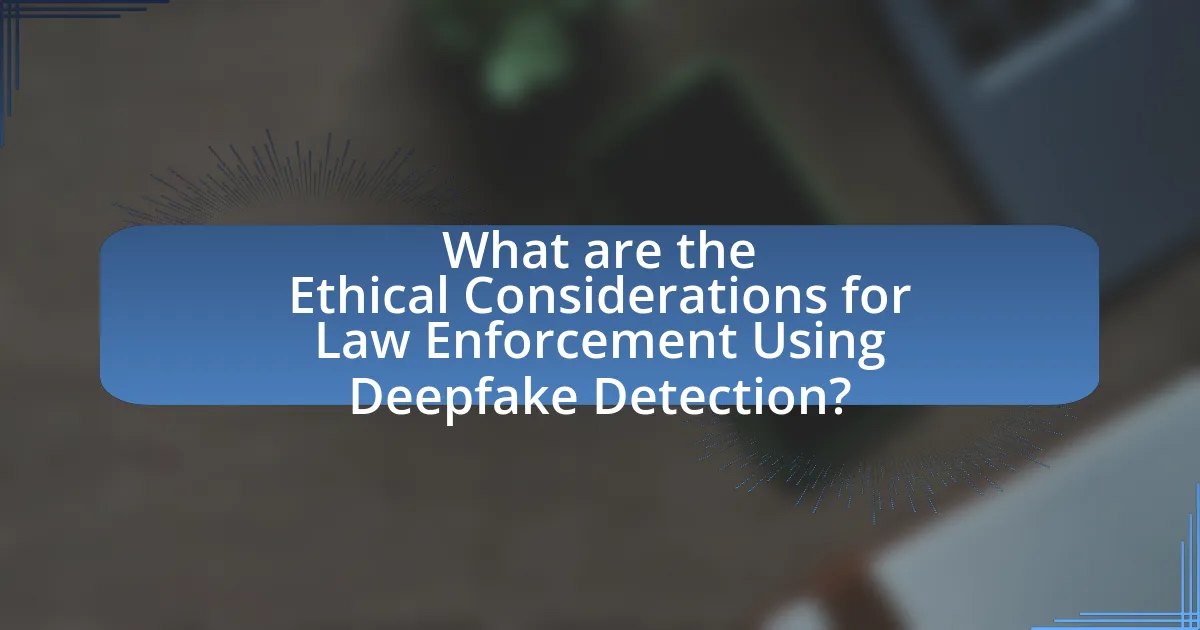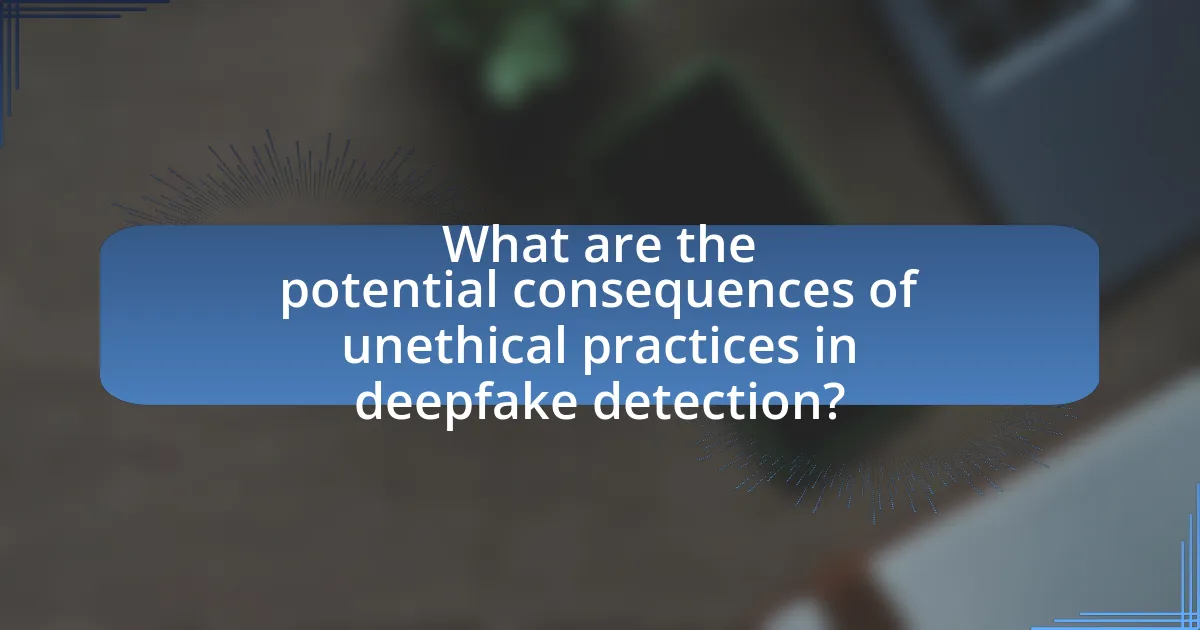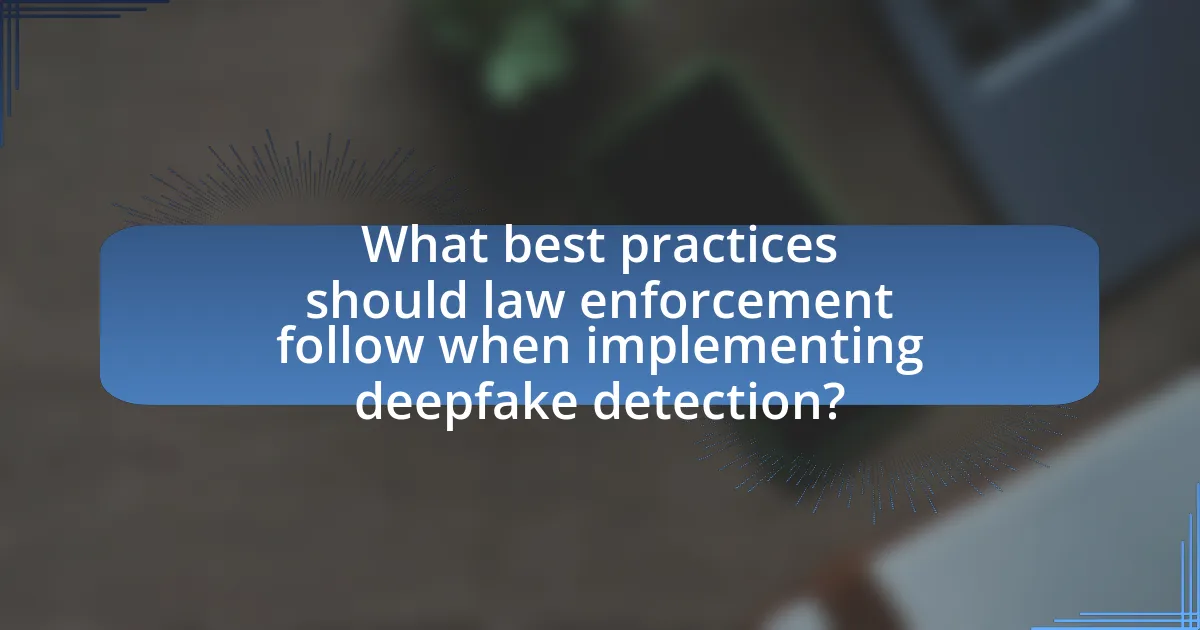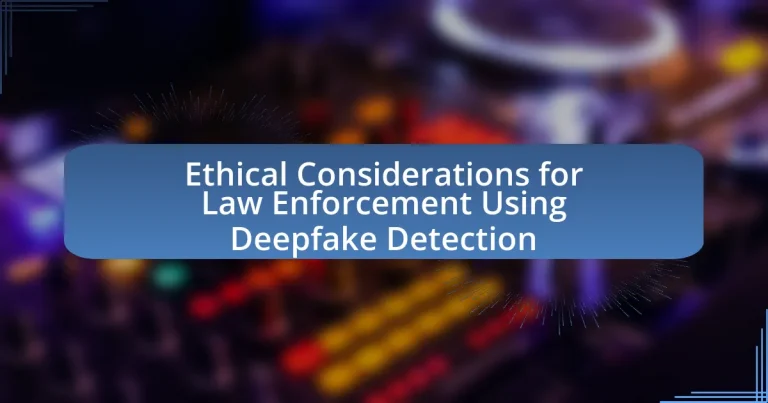The article focuses on the ethical considerations surrounding law enforcement’s use of deepfake detection technology. It highlights critical issues such as privacy rights, consent, and the potential for misuse, emphasizing the risks of false accusations and the erosion of public trust. The importance of deepfake detection in preventing criminal activities and maintaining the integrity of the justice system is discussed, alongside the ethical dilemmas that arise from its implementation. Additionally, the article outlines best practices for law enforcement to balance effectiveness with ethical standards, including transparency, accountability, and community engagement.

What are the Ethical Considerations for Law Enforcement Using Deepfake Detection?
Law enforcement’s use of deepfake detection raises significant ethical considerations, primarily concerning privacy, consent, and the potential for misuse. The deployment of such technology can infringe on individual privacy rights, as it may involve surveillance or analysis of personal data without explicit consent. Furthermore, the accuracy of deepfake detection tools is not infallible; false positives can lead to wrongful accusations or harm to innocent individuals. The potential for these technologies to be misused for manipulation or coercion in investigations also poses ethical dilemmas. For instance, reliance on deepfake detection could lead to overreach in law enforcement practices, undermining public trust. These considerations necessitate a careful balance between the benefits of enhanced investigative capabilities and the protection of civil liberties.
Why is deepfake detection important for law enforcement?
Deepfake detection is crucial for law enforcement because it helps prevent the misuse of manipulated media that can undermine public trust and facilitate criminal activities. The proliferation of deepfakes poses significant risks, including the potential for identity theft, fraud, and the spread of misinformation, which can disrupt investigations and legal proceedings. For instance, a study by the University of California, Berkeley, found that deepfakes could be used to create false evidence, leading to wrongful accusations or convictions. Therefore, effective detection methods are essential for maintaining the integrity of the justice system and protecting individuals from harm.
What risks do deepfakes pose to public safety and justice?
Deepfakes pose significant risks to public safety and justice by enabling the creation of misleading and harmful content that can manipulate public perception and undermine trust in legitimate media. These fabricated videos or audio recordings can be used to falsely implicate individuals in crimes, leading to wrongful accusations and potential legal consequences. For instance, a deepfake could show a person committing an act of violence, which could incite public outrage and prompt law enforcement actions based on false evidence. Additionally, deepfakes can erode trust in authentic communications, making it difficult for authorities to discern real threats from fabricated ones, thereby complicating investigations and response efforts. The potential for deepfakes to disrupt social order and justice systems is underscored by incidents where manipulated content has led to real-world violence or unrest, highlighting the urgent need for effective detection and regulation measures.
How can deepfake detection enhance law enforcement capabilities?
Deepfake detection can enhance law enforcement capabilities by providing tools to identify and mitigate the risks associated with manipulated media. This technology allows law enforcement agencies to verify the authenticity of video and audio evidence, which is crucial in investigations and court proceedings. For instance, a study by the University of California, Berkeley, demonstrated that advanced deepfake detection algorithms can achieve over 90% accuracy in identifying synthetic media, thereby supporting the integrity of evidence presented in legal contexts. By employing these detection methods, law enforcement can prevent the misuse of deepfakes in criminal activities, such as fraud or defamation, ultimately strengthening public trust and safety.
What ethical dilemmas arise from using deepfake detection in law enforcement?
The ethical dilemmas arising from using deepfake detection in law enforcement include issues of privacy, potential misuse of technology, and the risk of false accusations. Privacy concerns emerge as deepfake detection may involve surveillance and data collection without consent, infringing on individuals’ rights. The potential misuse of deepfake detection technology can lead to wrongful arrests or the manipulation of evidence, undermining the justice system. Furthermore, the risk of false accusations increases if the technology is not accurate, which can damage reputations and lives, as evidenced by studies indicating that deepfake detection systems can have varying degrees of reliability, leading to significant consequences in legal contexts.
How does the potential for misuse of deepfake detection tools impact ethical considerations?
The potential for misuse of deepfake detection tools significantly complicates ethical considerations in law enforcement. Misuse can lead to wrongful accusations, as law enforcement may rely on flawed detection algorithms that misidentify genuine content as fake, resulting in violations of individuals’ rights. For instance, a study by the University of California, Berkeley, highlights that deepfake detection tools can have high false positive rates, which can unjustly implicate innocent individuals in criminal activities. This misuse raises concerns about accountability, transparency, and the potential for abuse of power, as law enforcement agencies may prioritize efficiency over ethical standards, leading to a loss of public trust.
What are the implications of privacy concerns in deepfake detection?
Privacy concerns in deepfake detection primarily imply potential violations of individual rights and the risk of misuse of personal data. As law enforcement agencies utilize deepfake detection technologies, they may inadvertently infringe on privacy by surveilling individuals without consent or misidentifying innocent parties as perpetrators. For instance, the deployment of facial recognition systems in conjunction with deepfake detection can lead to unauthorized data collection, raising ethical questions about consent and the right to privacy. Furthermore, studies indicate that the use of such technologies can disproportionately affect marginalized communities, exacerbating existing biases and leading to wrongful accusations. These implications necessitate stringent regulations and ethical guidelines to ensure that privacy is respected while leveraging deepfake detection for public safety.
How can law enforcement balance effectiveness and ethics in deepfake detection?
Law enforcement can balance effectiveness and ethics in deepfake detection by implementing transparent algorithms and ensuring accountability in their use. Transparency in the algorithms allows for public scrutiny, which can help mitigate biases and ensure that the technology is used fairly. For instance, the use of explainable AI models can help law enforcement justify their decisions based on deepfake detection, thereby maintaining public trust. Additionally, establishing clear guidelines and oversight mechanisms can prevent misuse of the technology, ensuring that it is applied ethically while still being effective in identifying malicious deepfakes. Studies have shown that ethical frameworks in technology deployment can enhance public confidence and cooperation, which is crucial for law enforcement’s effectiveness.
What guidelines should be established for ethical use of deepfake detection technology?
Guidelines for the ethical use of deepfake detection technology should include transparency, accountability, and respect for privacy. Transparency requires law enforcement agencies to disclose the use of deepfake detection tools to the public, ensuring that citizens are aware of how their data may be analyzed. Accountability mandates that agencies establish clear protocols for the use of this technology, including oversight mechanisms to prevent misuse. Respect for privacy involves safeguarding individuals’ personal information and ensuring that detection efforts do not infringe on civil liberties. These guidelines are essential to maintain public trust and uphold ethical standards in law enforcement practices.
How can transparency and accountability be maintained in deepfake detection practices?
Transparency and accountability in deepfake detection practices can be maintained through the implementation of standardized protocols and independent audits. Standardized protocols ensure that detection methods are consistent and verifiable, allowing for reproducibility in results. Independent audits by third-party organizations can assess the effectiveness and fairness of detection technologies, ensuring that they are not biased or misused. For instance, the National Institute of Standards and Technology (NIST) has developed guidelines for evaluating the performance of deepfake detection tools, which can serve as a benchmark for accountability. By adhering to these practices, law enforcement can foster trust and ensure ethical use of deepfake detection technologies.

What are the potential consequences of unethical practices in deepfake detection?
Unethical practices in deepfake detection can lead to significant consequences, including the erosion of public trust in law enforcement and the potential for wrongful accusations. When law enforcement agencies employ biased or inaccurate detection methods, they risk misidentifying individuals as perpetrators based on manipulated media, which can result in legal repercussions and damage to reputations. Furthermore, the misuse of deepfake technology for malicious purposes, such as creating false evidence, can undermine the integrity of judicial processes. Studies have shown that public confidence in law enforcement diminishes when citizens perceive that technology is being misused, leading to decreased cooperation and increased societal division.
What legal ramifications could arise from misuse of deepfake detection?
Misuse of deepfake detection can lead to significant legal ramifications, including defamation lawsuits, violations of privacy rights, and potential criminal charges for fraud or misinformation. For instance, if law enforcement improperly uses deepfake detection technology to falsely accuse an individual, that individual may pursue a defamation claim based on the harm to their reputation. Additionally, unauthorized surveillance or misrepresentation through deepfake detection could infringe on privacy rights, leading to civil liability under laws such as the California Consumer Privacy Act. Furthermore, if deepfake detection is manipulated to produce false evidence, individuals involved could face criminal charges related to fraud or conspiracy, as seen in cases where technology has been misused to create misleading narratives.
How can wrongful accusations impact individuals and communities?
Wrongful accusations can severely damage the lives of individuals and the fabric of communities. Individuals falsely accused may experience emotional distress, loss of reputation, and financial hardship due to legal fees or job loss. For instance, a study by the National Registry of Exonerations found that wrongful convictions can lead to an average of 14 years of imprisonment, significantly impacting mental health and social relationships. Communities suffer as well, as trust in law enforcement and judicial systems erodes, leading to increased fear and division among residents. This breakdown in trust can hinder cooperation with police, ultimately compromising public safety and community cohesion.
What are the long-term effects on public trust in law enforcement?
Long-term effects on public trust in law enforcement include a significant decline in confidence and perceived legitimacy. Research indicates that incidents of misconduct, particularly those amplified by technology such as deepfakes, can lead to lasting skepticism among communities. For instance, a study by the Pew Research Center found that 64% of Americans believe that police do not treat all racial and ethnic groups equally, which undermines trust. Additionally, when law enforcement agencies utilize deepfake detection technology without transparency, it can further alienate the public, as citizens may feel their privacy is compromised. This erosion of trust can result in decreased cooperation with law enforcement, making it more challenging to maintain public safety and community relations.
How can law enforcement agencies mitigate ethical risks associated with deepfake detection?
Law enforcement agencies can mitigate ethical risks associated with deepfake detection by implementing transparent policies and training programs that emphasize ethical standards. These agencies should establish clear guidelines on the use of deepfake detection technologies, ensuring that they respect privacy rights and civil liberties. For instance, the International Association of Chiefs of Police recommends that law enforcement develop protocols that include oversight mechanisms to prevent misuse and ensure accountability. Additionally, ongoing training for personnel on the ethical implications of deepfake technology can help foster a culture of responsibility and awareness, reducing the likelihood of unethical practices.
What training and education are necessary for law enforcement personnel?
Law enforcement personnel require a combination of formal education and specialized training to effectively perform their duties. Typically, a high school diploma or equivalent is the minimum requirement, but many agencies prefer candidates with an associate’s or bachelor’s degree in criminal justice, forensic science, or a related field.
In addition to educational qualifications, law enforcement personnel undergo extensive training at police academies, which includes physical fitness, firearms training, legal education, and ethical decision-making. Specialized training in areas such as digital forensics and deepfake detection is increasingly important, given the rise of technology-related crimes.
For instance, the International Association of Chiefs of Police emphasizes the need for ongoing education and training in emerging technologies to ensure law enforcement can effectively address new challenges. This structured approach to education and training equips personnel with the necessary skills to navigate complex ethical considerations, particularly in the context of deepfake detection.
How can collaboration with technology experts enhance ethical practices?
Collaboration with technology experts can enhance ethical practices by integrating advanced knowledge and tools that ensure responsible use of technology in law enforcement. This partnership allows for the development of robust frameworks that address ethical concerns, such as privacy, bias, and accountability in deepfake detection. For instance, technology experts can provide insights into algorithmic transparency, helping law enforcement agencies understand the limitations and potential biases of detection systems. Research indicates that ethical guidelines informed by expert collaboration can lead to more equitable outcomes, as seen in studies like “Ethics of AI in Law Enforcement” by the AI Ethics Lab, which emphasizes the importance of interdisciplinary approaches in mitigating risks associated with emerging technologies.

What best practices should law enforcement follow when implementing deepfake detection?
Law enforcement should prioritize transparency and collaboration with technology experts when implementing deepfake detection. Transparency ensures that the public is informed about the methods and technologies used, fostering trust and accountability. Collaboration with experts allows law enforcement to utilize the latest advancements in detection technology, which is crucial given the rapid evolution of deepfake techniques. For instance, a study by the University of California, Berkeley, highlights that partnerships with academic institutions can enhance the effectiveness of detection algorithms, improving accuracy rates in identifying manipulated content. Additionally, law enforcement agencies should establish clear guidelines and protocols for the ethical use of deepfake detection tools, ensuring that civil liberties are respected and that the technology is not misused.
How can law enforcement ensure responsible use of deepfake detection technology?
Law enforcement can ensure responsible use of deepfake detection technology by implementing strict guidelines and oversight mechanisms. These guidelines should include transparency in the technology’s application, ensuring that its use is justified and documented in cases of investigation. Additionally, law enforcement agencies should engage in regular training for personnel on ethical considerations and the potential implications of misusing deepfake detection tools. Research indicates that misuse of such technology can lead to significant legal and social repercussions, highlighting the need for accountability measures. For instance, the European Union’s regulations on artificial intelligence emphasize the importance of ethical standards in technology deployment, which can serve as a framework for law enforcement agencies.
What role does community engagement play in ethical deepfake detection?
Community engagement plays a crucial role in ethical deepfake detection by fostering transparency and trust between law enforcement and the public. Engaging communities allows for the sharing of knowledge about deepfake technology, its implications, and the ethical considerations surrounding its use. This collaboration can lead to the development of community-driven guidelines and best practices that ensure deepfake detection methods are used responsibly and ethically. For instance, initiatives like public forums and educational workshops can enhance awareness and understanding, which is essential for mitigating misinformation and protecting civil liberties. Studies have shown that when communities are involved in discussions about technology, they are more likely to support ethical practices and contribute to the development of effective detection strategies.
How can ongoing evaluation and adaptation improve ethical standards?
Ongoing evaluation and adaptation can significantly improve ethical standards by ensuring that practices remain relevant and responsive to emerging challenges. Regular assessments allow organizations to identify gaps in ethical practices and adjust policies accordingly, fostering a culture of accountability. For instance, in law enforcement, continuous feedback mechanisms can help address biases in deepfake detection technologies, ensuring that these tools are used fairly and justly. Research indicates that organizations that implement iterative evaluations are more likely to uphold ethical standards, as they can adapt to new information and societal expectations, thereby enhancing public trust and legitimacy.
What resources are available for law enforcement to navigate ethical considerations in deepfake detection?
Law enforcement agencies can utilize several resources to navigate ethical considerations in deepfake detection, including guidelines from organizations like the International Association of Chiefs of Police (IACP) and the Federal Bureau of Investigation (FBI). These organizations provide frameworks that address the ethical implications of using deepfake technology in investigations, emphasizing the importance of transparency, accountability, and the protection of civil liberties. Additionally, academic research, such as studies published in the Journal of Law and Cyber Warfare, offers insights into the legal and ethical challenges posed by deepfakes, helping law enforcement develop informed policies. Furthermore, training programs and workshops focused on digital forensics and ethical decision-making can enhance officers’ understanding of the complexities involved in deepfake detection.
What organizations provide guidelines and support for ethical practices?
Organizations that provide guidelines and support for ethical practices include the International Association of Chiefs of Police (IACP), the American Psychological Association (APA), and the Association for Computing Machinery (ACM). The IACP offers resources and best practices for law enforcement agencies, focusing on ethical standards in policing. The APA provides ethical guidelines for psychological practices, which can be relevant in understanding the implications of deepfake technology on mental health and public perception. The ACM has a code of ethics that addresses the responsibilities of computing professionals, including those involved in developing and implementing deepfake detection technologies. These organizations contribute to establishing ethical frameworks that guide the responsible use of technology in law enforcement.
How can law enforcement agencies stay informed about emerging ethical issues?
Law enforcement agencies can stay informed about emerging ethical issues by actively engaging in continuous education and training programs focused on ethics in technology. These programs should include workshops, seminars, and online courses that address the ethical implications of new technologies, such as deepfake detection. Research indicates that ongoing training enhances awareness and understanding of ethical dilemmas, as seen in studies conducted by the International Association of Chiefs of Police, which emphasize the importance of ethics in policing practices. Additionally, agencies can establish partnerships with academic institutions and ethics boards to access the latest research and discussions on ethical challenges, ensuring they remain updated on best practices and emerging concerns in the field.
What practical steps can law enforcement take to implement ethical deepfake detection?
Law enforcement can implement ethical deepfake detection by establishing clear guidelines for the use of detection technologies, ensuring transparency in their methodologies, and prioritizing privacy rights. First, law enforcement agencies should develop and adopt standardized protocols that outline the ethical use of deepfake detection tools, which can help mitigate misuse and ensure accountability. For instance, the International Association of Chiefs of Police recommends creating policies that define acceptable use cases and the limits of technology application.
Second, transparency is crucial; agencies should publicly disclose the technologies they use and the criteria for their deployment, fostering public trust and understanding. This aligns with ethical standards set by organizations like the IEEE, which emphasizes the importance of transparency in AI applications.
Lastly, prioritizing privacy rights involves implementing measures to protect individuals’ data and ensuring that detection efforts do not infringe on civil liberties. The General Data Protection Regulation (GDPR) in Europe serves as a model for how law enforcement can balance the need for security with the protection of personal information. By following these steps, law enforcement can ethically navigate the challenges posed by deepfake technology.


